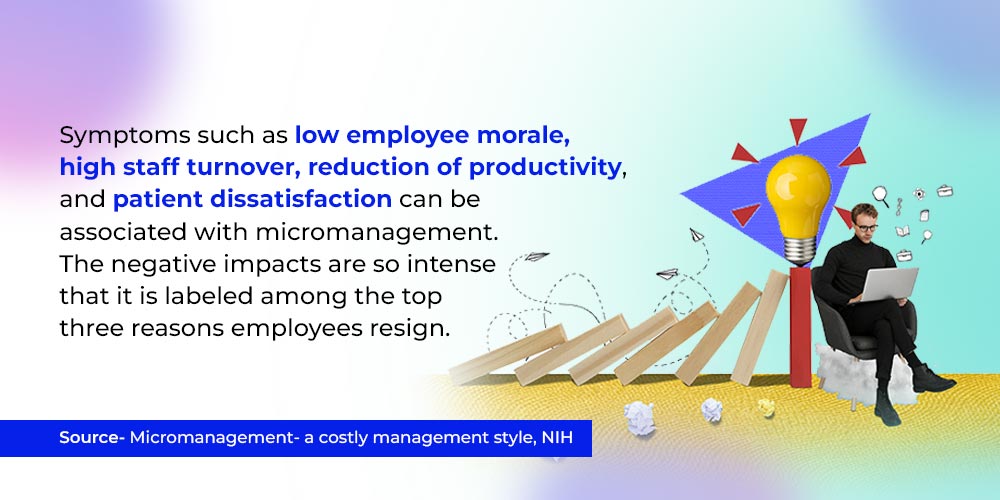No More Micromanagement: Empower Teams with Proven Strategies!
Are you tired of feeling suffocated by your boss’s constant need to oversee every little thing you do? Micromanagement can turn a dream job into a nightmare faster than you can say “Let me breathe!” Let’s talk about why micromanagement is a big no-no and how you can empower your team while still keeping things under control.
Micromanagement is like that annoying little sibling who always wants to know what you’re up to. In the blink of an eye, it kills motivation, creativity, and trust. A boss who is constantly on your back makes it hard to feel like you have any autonomy or ownership over your work. Plus, it’s just plain annoying!


As a matter of fact
Micromanagement is a term that often conjures up feelings of frustration and stifled creativity among employees. It refers to a management style where leaders closely oversee and control every aspect of their team’s work, leaving little room for autonomy or independent decision-making. Despite the belief that closely monitoring employee behavior will improve quality and efficiency, micromanagement can negatively impact a team’s morale and productivity.
Signs of Micromanagement
- Constant Monitoring: Micro-managers tend to excessively monitor their team members’ activities, often requesting frequent updates or progress reports.
- Lack of Trust: Micro-managers struggle to delegate tasks and often feel the need to personally oversee every aspect of a project, demonstrating a lack of trust in their team’s abilities.
- Excessive Criticism: Micro-managers may nitpick minor details and offer constant criticism, which can erode confidence and motivation among team members.
- Inflexibility: Micro-managers are often rigid in their approach and unwilling to consider alternative viewpoints or suggestions from their team.
Pitfalls of micromanagement
The negative impacts of micromanagement can be far-reaching, affecting not only individual team members but also the overall performance of the organization.
- Decreased Morale: Micromanagement can lead to feelings of resentment and disengagement among team members, as they may feel undervalued and incapable of making meaningful contributions.


- Stifled Creativity: Constant oversight and control can hinder creativity and innovation within a team, as team members may be reluctant to take risks or think outside the box.
- Reduced Productivity: Micromanagement can cause team members to spend more time seeking approval and clarification from their manager than actually doing their job.
- High Turnover Rates: Employees who feel micromanaged are more likely to seek opportunities elsewhere, leading to increased turnover rates and potential talent loss for the organization.
Empowering employees: Best practices
Empowering employees is essential for fostering a culture of innovation, collaboration, and high performance within an organization. However, it’s equally important to avoid falling into the trap of micromanagement, which can stifle creativity and autonomy.
Here are some best practices to steer clear of micromanagement:
- Set Clear Expectations:
- Communicate goals, objectives, and expectations to your team members. Ensure that they understand what is expected of them and how their work contributes to the organization’s overall success.
- Delegate Authority:
- Delegate tasks and responsibilities to your team members, empowering them to take ownership of their work. Provide them with the autonomy to make decisions and execute tasks according to their expertise.
- Encourage Initiative:
- Foster a culture of initiative and proactivity within your team. Encourage team members to identify opportunities for improvement, propose innovative solutions, and take on new challenges.
- Provide Support and Resources:
- Offer guidance, mentorship, and support to your team members as needed. Provide them with the resources, training, and tools necessary to succeed in their roles.
- Promote Open Communication:
- Create an environment where open communication is encouraged and valued. Listen to your team members’ ideas, concerns, and feedback, and consider their input when making decisions.
- Offer Constructive Feedback:
- Provide regular feedback to your team members, focusing on their strengths and improvement areas. Offer constructive feedback aimed at helping them grow and develop in their roles.
- Trust and Empower:
- Trust your team members to make sound decisions and take ownership of their work. Instead of micromanaging or second-guessing their actions, empower them to use their skills and expertise.
- Lead by Example:
- Lead by example and demonstrate the behaviors and values you want to see in your team. Show trust, respect, and confidence in your team members, and they will be more likely to reciprocate.
- Promote Collaboration:
- Encourage collaboration and teamwork within your team. Foster a supportive and inclusive environment where team members feel comfortable sharing ideas, collaborating on projects, and working together towards common goals.
- Celebrate Successes:
- Recognize and celebrate the achievements and successes of your team members. Acknowledge their contributions and efforts, and provide positive reinforcement to motivate them to continue performing at their best.
The Dichotomy
Micro-managers and Macro-managers operate at opposite ends of the management spectrum, with distinct differences in their approaches, attitudes, and behaviors. Understanding these disparities is crucial for fostering a healthy work environment and maximizing team effectiveness.
Here are the key differences between Micro-managers and Macro-managers:
- Control vs. Trust:
- Micro-managers exert tight control over every aspect of their team’s work, often dictating how tasks should be performed and closely monitoring progress.
- Macro-managers trust their team members to make decisions and manage their work autonomously; they provide guidance and support but allow for flexibility in the approach and execution of tasks.
- Involvement vs. Delegation:
- Micro-managers tend to be highly involved in day-to-day operations, frequently inserting themselves into the minutiae of tasks and processes.
- Macro-managers delegate authority and responsibility to their team members, empowering them to take ownership of their work and make decisions independently.
- Communication Style:
- Micro-managers often employ directive communication, issuing orders and instructions with little room for discussion or input from team members.
- Macro-managers prioritize open communication and collaboration, encouraging dialogue, sharing ideas, and seeking input from their team to foster innovation and problem-solving.
- Feedback Approach:
- Micro-managers may offer feedback in a critical or controlling manner, focusing on perceived mistakes or deviations from their instructions.
- Macro-managers provide constructive feedback aimed at empowering team members to learn and grow. They recognize achievements and guide improvement in a supportive and encouraging manner.
- Focus on Results vs. Process:
- Micro-managers often prioritize adherence to specific processes or procedures, sometimes at the expense of efficiency or creativity.
- Macro-managers focus on achieving desired outcomes, allowing flexibility in how tasks are approached as long as the result meets expectations and objectives.
- Trust in Team Competence:
- Micro-managers may doubt the competence of their team members, leading them to closely monitor and control their work.
- Macro-managers have confidence in the abilities of their team members and empower them to use their skills and expertise to achieve goals without constant oversight.
- Impact on Team Morale:
- Micro-management can lead to low morale and motivation among team members, as they may feel undervalued, micromanaged, and lacking autonomy.
- Macro-management fosters a positive work environment where team members feel trusted, empowered, and motivated to contribute their best efforts.
Ultimately, the key to effective management lies in finding the right balance between control and empowerment. Leaders can empower their teams to excel by cultivating a culture of trust, autonomy, and open communication while still ensuring quality and consistency with sufficient oversight. Embracing a more empowering approach to management can lead to happier, more engaged employees and ultimately, greater success for the organization as a whole.
So, say goodbye to micromanagement and hello to empowered, happy teams! Trust us, your team will thank you for it, and your sanity will thank you too.







